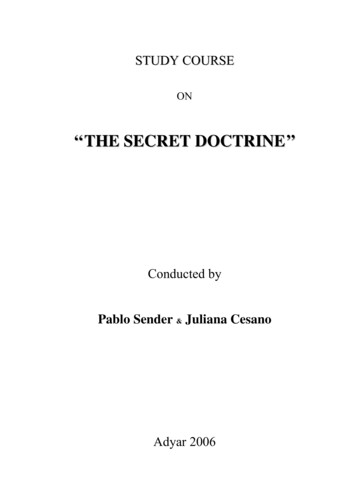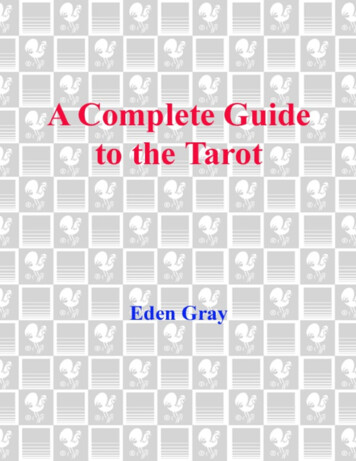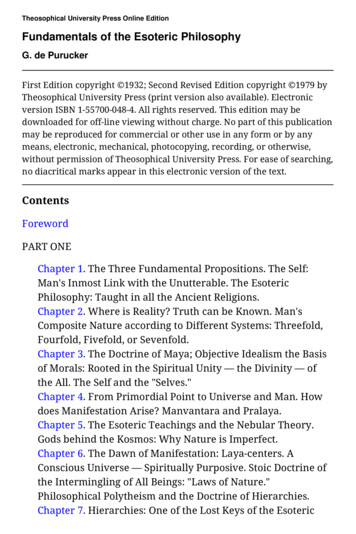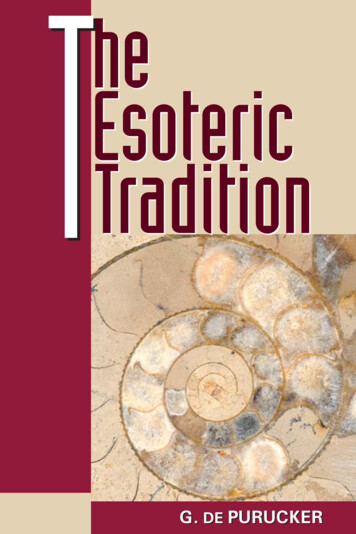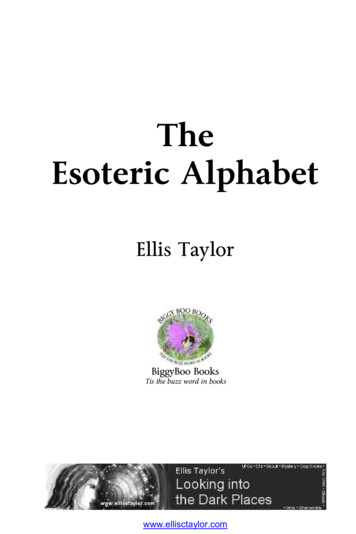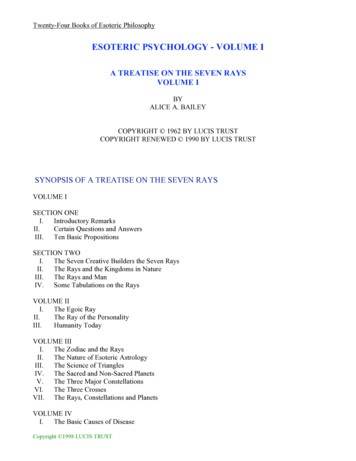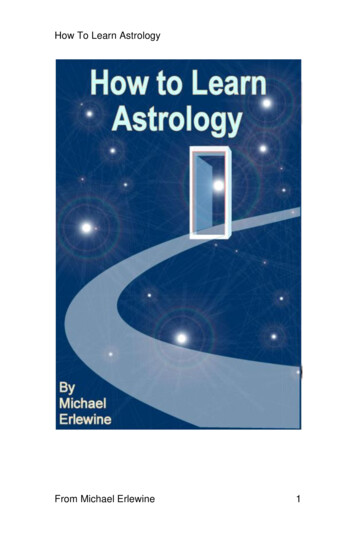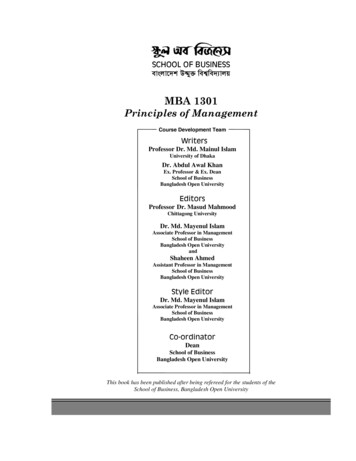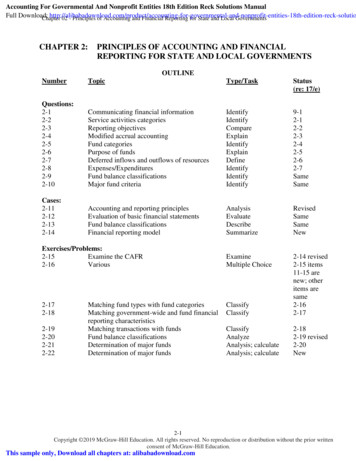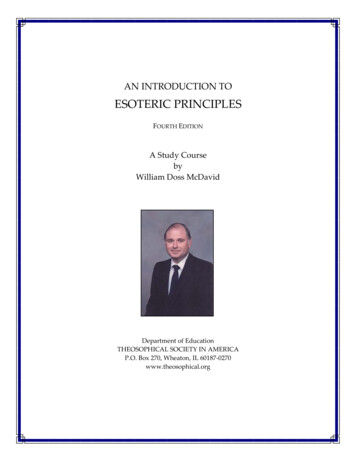
Transcription
AN INTRODUCTION TOESOTERIC PRINCIPLESFOURTH EDITIONA Study CoursebyWilliam Doss McDavidDepartment of EducationTHEOSOPHICAL SOCIETY IN AMERICAP.O. Box 270, Wheaton, IL 60187-0270www.theosophical.org
Dedication:To the treasured memory ofJohn Posey, Theosophist and Unknown PhilosopherCopyright 1977 by the Theosophical Society in AmericaSecond Edition 1990, 1996. Third Edition (online version) 2007.Fourth Edition 2008.
Abide With MeAbide with me, Thou Atmic Ray Divine,And shed Thy Light upon this soul of mine;I have no hope, no source of light but Thee;O Thou, possessing all, abide with me.When sickness rages, clouds around me throng,Be this my consolation and my song:“The Lord of Light, can ne’er unfaithful be,And this great King of Kings abides with me.”I fear not what this world may do or say;I only fear the foe that doth betray—My lower self, that shrinks away from Thee—But thou art patient, Lord; abide with me.I ask not ease, immunity from pain;For discipline, I know, is always gain;But sometimes, Lord, unveil and smile on me,Unworthy though I am; Abide with me.Thus through all ills, all sorrows, sickness, pain,Thy hand shall guide, my lower self restrain;And daily shall this prayer arise to Thee:“Oh King of Peace, my God, abide with me.”—Wilton HackThe TheosophistJune 1899
ContentsPrefacevii1.Introduction—Schools of Esoteric Teaching12.First Principles73.Microcosm154.Evolution—The Law of Unfoldment255.Macrocosm336.The Scope of Planetary Evolution477.The Path of Initiation63Source Materials75Appendix IThe Seven Principles77Divisions of the Human Constitution81Appendix IIThe Progress of the Lunar Monads83Appendix IIIThe Twelve Creative Hierarchies87Occult Correspondences88Bibliography89
PREFACEOne of the most difficult tasks before the student of Theosophy is to bridge the gapbetween the elementary and the more advanced studies. Our literature contains manyexamples of both extremes, but there are relatively few presentations which attempt tolead the student across the abyss which separates the two. An attempt has been made inthis work to aid in bridging this abyss to some extent. It is assumed that the reader hasread or studied some of the available Theosophical literature and has tried—perhaps heor she may think unsuccessfully—to read some of the more difficult works. It is hopedthat this guide for study will provide at least the fundamentals which will prepare thestudent to tackle the more advanced materials, to wrestle with the perplexing questionscontained therein, and to form his or her own opinions intelligently. Knottyphilosophical problems and difficult points in the teaching have been dealt with as wellas some of the less technical aspects.It seems necessary to point out with complete honesty and candor those pointswhere later writers seem to be at variance with or diverge from the teaching given by H.P. Blavatsky and the Masters of Wisdom in the early days of the Theosophical Society.To do so is to lay oneself open to the charge of setting up HPB as an authority. On thatpoint, the writer can only plead guilty and beg for mercy.The writer also begs forgiveness for diverging from the teaching in those placeswhere his own understanding is imperfect. Such is the curse which falls upon the headsof those of us who presume to write about Theosophy without ourselves being, as HPBwas, the direct amanuensis of the Mahatmas.Each time this study manual has been reprinted, I have been tempted to make allsorts of changes to reflect my changing understanding over the years. Such an extensiverevision would involve altering and expanding the text so greatly that it would nolonger serve the purpose for which it was written. I have therefore contented myselfwith a minimum number of changes in hopes that the guide will continue to be usefulto a certain class of students. This time around I am particularly grateful to DavidBruce and Nicholas Weeks for reviewing the manuscript and making suggestions for itsimprovement.William Doss McDavidSan Antonio, TX 2008vii
viii
The Theosophical Society in AmericaChapter 1Schools of Esoteric TeachingTheosophy has been called the Wisdom Religion. The word stems from the Greekwords “theos” (God) and “sophia” (Wisdom) and refers to the “Wisdom of the Gods.”This Divine Wisdom, tradition relates, was brought to earth in the infancy of humanityby a superhuman race, the leaders of which have been remembered as the gods andlegendary heroes of mythology. It was these great beings who taught humanity its firstlessons in science, art, and philosophy and who laid the foundations for world culture.It is said that the Divine Wisdom was taught openly to the first human races. It wasonly during the time of the fourth, or Atlantean, race that it became hidden from thesight of the majority. The reason for this secrecy was explained by Helena PetrovnaBlavatsky in the following words:The first, semi-divine, pure and spiritual Races of Humanity . . . had the “truthsof God,” and lived up to them, and their ideals. They preserved them, as long asthere was hardly any evil, and hence scarcely a possible abuse of that knowledgeand those truths. But evolution and the gradual fall into materiality is also one ofthe “truths” and also one of the laws of “God.” And as mankind progressed, andbecame with every generation more of the earth, earthly, the individuality ofeach temporary Ego began to assert itself. It is personal selfishness that developsand urges man on to the abuse of his knowledge and power. And selfishness is ahuman building, whose windows and doors are forever wide open for everykind of iniquity to enter man’s soul . . . Hence the necessity of gradually takingaway from man the divine knowledge and power, which became with every newhuman cycle more dangerous as a double-edged weapon, whose evil side wasever threatening one’s neighbor, and whose power for good was lavished freelyonly upon self. Those few “elect” whose inner natures had remained unaffectedby their outward physical growth, thus became in time the sole guardians of themysteries revealed, passing the knowledge to those most fit to receive it.(Collected Writings, 14:40-41)Thus from those days were established the Mystery Schools in which the WisdomTeachings were preserved for the worthy.In the early days of this present fifth or Aryan race, the predominant seat of civilization was in Central Asia. It was there that the parent school, the chief and oldest ofthe Mystery Schools, was maintained. As the Aryans spread throughout the ancientworld, the Initiates among them established esoteric schools in all the greatest centers ofcivilization. It was under the direction of these Initiates that many of the temples andmonuments of antiquity were built. Often, the Aryans spread into regions where races1
The Theosophical Society in Americaof Atlantean descent were practicing their own forms of esotericism. Mingling with theolder races, the Aryan Initiates established schools of the mysteries adapted to the cultural and social conditions in which they found themselves. Thus the Wisdom Religion,which was one in its foundations, became differentiated into innumerable traditions.The ancient Brahmanical religion of India was the form which it assumed as the Aryansswept southward across the Himalayas. In Persia, it became the religion of the Magi,which was later to become the Parsi faith under the reforming influence of Zoroasters.In Egypt, building upon foundations laid by the Atlanteans, the King-Initiates taughtthe Wisdom Religion in the seclusion of pyramids and imposing temples that remain tothis day architectural wonders. Figure 1 suggests the diffusion of the primordialWisdom-Tradition resulting in the proliferation of schools of esoteric thought.Throughout the ancient world, therefore, the Initiates established Mystery Schoolsfor the worthy while, around these, popular religions full of myth and superstitiondeveloped among the multitudes. As civilization declined and mankind entered theDark Age or Kali Yuga, as it is sometimes called, the esoteric schools became moresecret and hidden from sight until their very existence passed from the public eye. Thiswas especially true in Western lands where the intolerance of the Roman CatholicChurch made it necessary for the Initiates to hide altogether from public scrutiny. Secretsocieties, such as the Rosicrucian Order and the Masonic fraternities, preserved the2
The Theosophical Society in Americateachings of the Wisdom Religion throughout the Middle Ages and down to the presenttime.A reform movement, encompassing all traditional esoteric orders the world over,was initiated around the time of the Lord Gautama Buddha and was brought to fruitionduring the life of the Tibetan teacher Tsong-kha-pa in the fourteenth century. A. P.Sinnett described this effort in the following words:Adeptship, when Buddha incarnated, was not the condensed, compact hierarchythat it has since become under his influence. There has never been an age of theworld without its adepts; but they have sometimes been scattered throughout theworld; they have sometimes been isolated in separate seclusions; they havegravitated now to this country, now to that; and finally, be it remembered, theirknowledge and power has not always been inspired with that elevated andsincere morality which Buddha infused into its latest and highest organization.The reform of the occult world by his instrumentality was, in fact, the result ofhis great sacrifice, of the self-denial which induced him to reject the blessedcondition of Nirvana to which, after his earth-life as Buddha, he was fully entitled, and undertake the burden of renewed incaгnations1 in order to carry outmore thoroughly the task he had taken in hand, and confer a correspondinglyincreased benefit on mankind. (Esoteric Buddhism, pp. 132-133)His third appearance was in the person of Tsong-kha-pa,2 the great Tibetan adeptreformer of the fourteenth century. In this personality he was exclusively concerned with the affairs of the adept fraternity, by that time collecting chiefly inTibet. From time immemorial there had been a certain secret region in Tibet,which to this day is quite unknown to and unapproachable by any but initiatedpersons, and inaccessible to the ordinary people of the country as to any others.But the country generally was not in Buddha’s time, as it has since become,3 thechosen habitation of the great brotherhood. Much more than they are at present,were the Mahatmas in former times distributed about the world. The progress ofcivilization, engendering the magnetism they find so trying, had, however, bythe date with which we are now dealing—the fourteenth century—already givenrise to a very general movement toward Tibet on the part of the previouslydissociated occultists. Far more widely than was held consistent with the safetyof mankind was occult knowledge and power then found to be disseminated. To1We are treading here upon very sacred territory. A few hints on Buddha’s subsequent “incarnations” are given in“The Mystery of Buddha” and “ ‘Reincarnations’ of Buddha” in the so-called third volume of The Secret Doctrine(See Collected Writings, 14: 388–407).2This is not quite correct as there were other manifestations of the Buddha unknown to Mr. Sinnett when he wroteEsoteric Buddhism (see “ ‘Reincarnations’ of Buddha”).3This was written in 1883. HPB reportedly told James Morgan Pryse in 1890 that the Masters had begun to withdrawfrom Tibet (“Truth and Honesty,” The Canadian Theosophist 12, July 1931: 139).3
The Theosophical Society in Americathe task of putting it under the control of a rigid system of rule and law didTsong-kha-pa address himself.Without re-establishing the system on the previous unreasonable basis of casteexclusiveness, he elaborated a code of rules for the guidance of the adepts, theeffect of which was to weed out of the occult body all but those who soughtoccult knowledge in a spirit of the most sublime devotion to the highest moralprinciples. (Ibid., p. 138)As a result of this reform, the secret orders recognized and presided over by thehighest Initiates were unified and organized into a centralized federation and givensome new directives for guiding their activities. (See Theosophy, January 1938). One ofthese directives obligated them to participate in a continuing effort that had been goingon since the first century B.C.E. to restore the light of the mysteries to the Westernworld (Collected Writings, 12:120; 14:294-5). This effort is consistently made during thelast quarter of every century. Describing this effort, H. P. Blavatsky wrote as follows:Among the commandments of Tsong-kha-pa there is one that enjoins the Rahats(Arhats) to make an attempt to enlighten the world, including the “whitebarbarians,” every century, at a certain specified period of the cycle. (CollectedWritings, 14:431)We may tabulate briefly some of the events which have occurred in the last quarterof each century from the fourteenth to this day in seeming fulfillment of this plan:14th century“Foundation” of the fraternity of the Rosy Cross byChristian Rosenkreutz15th centuryWork of the Florentine Platonic AcademyIntroduction of printing into EuropeColumbus discovers the “new world”Birth of Paracelsus, the reformer of medicine16th centuryWork of Akbar in IndiaPublication of first “Shakespeare” playsFoundations laid for revival of Rosicrucian activityGiordano Bruno tries to reconcile Catholics andProtestants through Neoplatonism17th centuryPublication of Newton’s PrincipiaInfancy of the Royal SocietyEstablishment of the Rosicrucian Order in America18th centuryReform movements within Masonry led by CountsSt. Germain and CagliostroMagnetic healing taught by Mesmer4
The Theosophical Society in AmericaMartinism establishedBirth of the United States of America19th centuryEstablishment of the Theosophical Society by Blavatsky,Olcott, and JudgeMaha Bodhi Society foundedH
of mankind was occult knowledge and power then found to be disseminated. To 1 We are treading here upon very sacred territory. A few hints on Buddha’s subsequent “incarnations” are given in “The Mystery of Buddha” and “‘Reincarnations’ of Buddha” in the so-called third volume of The Secret DoctrineFile Size: 638KBPage Count: 98

